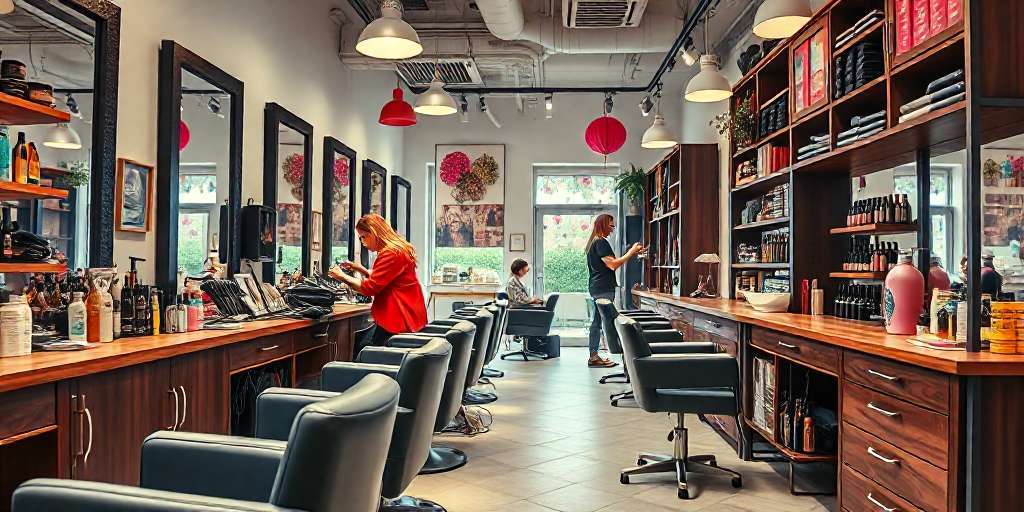Hairdresser Trends: Elevating Your Look with Style
Hairdressers play an essential role in personal grooming and self-expression. Their expertise in styling, cutting, and coloring hair significantly impacts clients’ appearance and confidence. The profession has evolved over time, influenced by various cultural practices and trends. From historical origins to modern techniques, hairdressing continues to adapt and thrive in today’s society.

Evolution of the Hairdressing Profession
The evolution of the hairdressing profession reflects changes in aesthetics, culture, and society. This journey spans from ancient history to modern techniques, highlighting the artistry involved in styling and the significant cultural roles hairdressers have played throughout the years.
Historical Significance and Cultural Impact
Hairdressing has deep historical roots, intertwined with societal norms to create a lasting cultural impact. In various civilizations, hair has often symbolized status, power, and identity.
- In Ancient Egypt, hairstyling indicated social standing. Nobles adorned their hair with elaborate wigs and rich ornaments.
- Greek and Roman societies regarded barbers as essential figures, with grooming being an integral part of daily life and social gatherings.
- During the Renaissance, intricate hairstyles became fashionable among European aristocracy, further elevating the role of stylists.
From Ancient Practices to Modern Methods
The transition from ancient practices to modern hairdressing reflects advancements in techniques and tools. Early methods primarily relied on natural resources and rudimentary implements.
- Barbers used simple tools like knives made from flint.
- During the Middle Ages, the introduction of metal scissors marked a technological advancement, enhancing precision in cuts.
- The 20th century ushered in innovative methods such as chemical processing and mechanical styling tools, revolutionizing the industry.
Hairdressing in Different Cultures
Hairdressing practices and styles vary greatly across cultures, influenced by traditions, rituals, and values. Each culture has developed unique approaches that reflect its social dynamics.
- In African cultures, hair is often deeply symbolic, representing beauty, spirituality, and social status. Elaborate hairstyles can denote age, marital status, or ethnicity.
- Asian cultures have their stylistic conventions, with countries like Japan renowned for intricate geisha hair. The techniques often involve complex arrangements and the use of traditional tools.
- Western cultures continue to evolve, blending contemporary styles with historic influences. Trends shift rapidly, showcasing a mix of vintage and modern aesthetics.
Understanding these diverse practices provides insight into how hairdressing mirrors broader social trends, making it an essential aspect of cultural identity.
Top Hairdresser Styles and Trends
In the ever-evolving world of hairdressing, staying current with styles and trends is essential. This section delves into popular haircut trends, innovative styling techniques, hair coloring advancements, and the diverse applications of extensions.
Popular Haircut Trends
Today’s haircut trends showcase a blend of classic and contemporary styles. Popular choices often reflect personal expression, with some of the most sought-after cuts including:
- Bob Cuts: A versatile choice that can be customized in length and texture, the bob remains a timeless favorite.
- Lob Cuts: The long bob offers a relaxed, chic look that works well for various hair types and lengths.
- Pixie Cuts: Perfect for those seeking a bold style, pixie cuts are low-maintenance and offer a fun, edgy appearance.
- Layered Cuts: Adding layers provides movement and volume, making it a great option for thicker hair.
- Fade Cuts: Popular among men, fade hairstyles complement various styles, from casual to formal, and can be adapted to personal taste.
Styling Techniques and Tools
Modern hairdressers utilize an array of styling techniques to craft looks that suit each individual. Essential tools include:
- Hairdryers and Brushes: These are fundamental for blowouts and creating volume, enhancing the overall look.
- Straighteners: Tools designed to create sleek finishes or flips, providing versatility in styling.
- Curling Irons: They enable the creation of waves and curls to add texture and movement to hairstyles.
- Hair Products: From pomades to sprays, a variety of products cater to specific needs, enabling hairdressers to achieve desired results.
Hair Coloring Innovations
The realm of hair coloring is constantly advancing, with numerous techniques capturing clients’ desires for unique looks. Popular trends include:
- Balayage: This freehand coloring technique creates natural, sun-kissed highlights that grow out beautifully.
- Ombre: A gradient effect, ombre blends darker roots with lighter ends, offering a striking contrast.
- Pastel Colors: Soft shades, such as lavender and mint, continue to trend, appealing to younger demographics looking for playful expressions.
- Foil Highlights: This classic technique allows for more control over the placement of color, leading to brighter and bolder results.
Extensions: Types and Applications
Hair extensions have transformed the way people enhance their hairstyles. They offer a solution for those looking to add length or volume. Common types include:
- Clip-In Extensions: These are temporary solutions that can be easily applied and removed, making them suitable for events.
- Tape-In Extensions: Known for their seamless look, these extensions are semi-permanent and are applied with adhesive strips.
- Sew-In Extensions: Often used with natural hair braids, sew-ins provide a more permanent solution for added length and volume.
- Fusion Extensions: These involve bonding small strands of extension hair to natural hair with keratin, offering a long-lasting style.
The Role of Hair Salons in the Community
Hair salons serve not just as places for grooming, but also as community hubs where people connect, share experiences, and improve their self-image. These establishments play an integral role in enriching the social fabric of neighborhoods.
Choosing the Right Salon Near You
Selecting an appropriate salon is paramount for individuals seeking a satisfying experience. Factors to consider include:
- Reputation and ReviewsWord-of-mouth recommendations and online reviews can significantly influence decision-making. Patrons often share their experiences on social media or review platforms, providing insight into the quality of service.
- Specializations and ExpertiseDifferent salons may focus on various stylistic trends or services. Identifying a salon that aligns with personal style preferences, such as color techniques or specific hair types, is essential for achieving desired results.
- Location and AccessibilityChoosing a conveniently located salon can enhance the overall experience. Proximity to home or work can play a crucial role in scheduling appointments without hassle.
Services Offered by Hair Salons
Hair salons provide a wide range of services tailored to meet the diverse needs of their clientele. Common offerings include:
- Haircuts and StylingSalons typically offer various haircut styles and techniques, accommodating requests for both trendy and classic looks. Stylists often provide hairstyling services for special occasions, ensuring clients look their best.
- Hair Coloring ServicesColoring services can range from simple highlights to advanced techniques like balayage or ombre. Professional colorists are trained to provide personalized consultations, helping clients find the perfect shades that complement their skin tone.
- Treatments and ConditioningSalons offer various treatments aimed at revitalizing and nourishing hair. Services may include deep conditioning, keratin treatments, and scalp massages, all intended to enhance hair health.
The Atmosphere and Experience
The environment of a hair salon can significantly contribute to the overall experience. Key elements include:
- AmbianceA welcoming atmosphere with pleasant decor and soothing music can make the visit more enjoyable. Many salons create a unique vibe that reflects their brand identity, influencing client satisfaction.
- Client InteractionThe approachability of the staff can enhance the salon experience. Friendly and attentive stylists foster an environment where clients feel comfortable discussing their needs and preferences.
- Community EngagementMany salons host events or partner with local businesses to strengthen community ties. This involvement not only promotes the salon but also contributes positively to local culture.
Health and Safety in Hairdressing
Health and safety are crucial aspects of the hairdressing profession. Ensuring a safe environment not only protects hairdressers but also clients, making it essential to follow established practices and regulations.
Handling Chemical Products Safely
The use of chemical products is common in hairdressing, including dyes, relaxers, and treatments. Proper handling is essential to minimize health risks. Professionals should adhere to guidelines such as:
- Wearing appropriate personal protective equipment (PPE) including gloves and masks.
- Using products in well-ventilated areas to limit inhalation of fumes.
- Storing chemicals securely and away from direct sunlight or heat sources.
- Reading and understanding Material Safety Data Sheets (MSDS) for each product.
Hygiene Practices in Salons
Maintaining high standards of hygiene is vital to avoid infections and ensure client safety. Salons must implement rigorous cleaning routines, which include:
- Sanitizing Tools: All equipment such as scissors, brushes, and combs should be sanitized after each use.
- Clean Workstations: Salons should regularly clean surfaces, including chairs and counters, to prevent the spread of germs.
- Hand Hygiene: Hairdressers should wash their hands frequently and may use hand sanitizer between clients.
Occupational Risks and Mitigation Strategies
Working as a hairdresser involves specific occupational risks, including musculoskeletal disorders, exposure to chemicals, and ergonomic challenges. Effective mitigation strategies include:
- Ergonomic Workstations: Setting up work areas that reduce strain on the body can prevent injuries.
- Regular Breaks: Taking breaks to stretch and move around can alleviate physical tension.
- Training: Continuous education on safety practices can enhance awareness among staff.
Regulations and Safety Standards
Various regulations govern hairdressing practices to safeguard both professionals and clients. Key aspects include:
- State Licensing: Most states require hairdressers to obtain licensure, ensuring they meet certain educational and practical standards.
- Health Inspections: Salons are subject to regular health inspections to ensure compliance with safety codes and sanitation practices.
- OSHA Standards: The Occupational Safety and Health Administration (OSHA) sets forth safety guidelines that all salons must follow to maintain a safe environment.
Careers and Professional Growth in Hairdressing
The hairdressing profession offers a dynamic environment for personal and professional development. From training requirements to working conditions, there are multiple facets contributing to a fulfilling career in this field.
Training and Education Requirements
A career in hairdressing requires a solid educational foundation. Individuals must undergo formal training to develop the necessary skills and knowledge.
State Licensing and Examinations
In the United States, each state has its own licensing requirements for hairdressers. After completing an accredited cosmetology program, aspiring hairdressers must pass a state examination, which typically includes both practical skills and written components. This process ensures that hairdressers are well-equipped to provide safe and effective services.
Continuing Education and Skill Development
Hairdressing is an ever-evolving field with continuous advancements in techniques and products. Professionals often participate in ongoing education, attending workshops, and seminars to stay current with trends and innovations. Many states mandate a certain amount of continuing education hours to maintain licensure, further promoting skill advancement and professional growth.
Working Conditions and Work Environment
The working environment of hairdressers can vary greatly depending on their employment setting. Factors such as hours, clientele, and job responsibilities all contribute to the overall experience.
Full-Time vs. Self-Employed Hairdressers
Hairdressers may choose to work as employees in established salons or as independent contractors running their own businesses. Full-time hairdressers often enjoy benefits such as health insurance and retirement plans, while self-employed stylists benefit from greater flexibility in scheduling and the potential for higher earnings.
Work-Life Balance: Evenings and Weekends
Many hairdressers work evenings and weekends to accommodate client schedules. This can impact personal life, requiring effective time management skills to maintain a healthy work-life balance. Establishing boundaries and scheduling regular downtime is crucial for long-term job satisfaction.
Interacting with Clients and Personal Care
The role of a hairdresser extends beyond technical skills; it involves building strong relationships with clients. Understanding individual needs and providing personalized care fosters loyalty and enhances the overall experience. Good communication is essential, as hairdressers often serve as confidants, creating a welcoming environment where clients feel comfortable sharing their thoughts and preferences.
The Personal Touch: Hairdressers as Artists and Confidants
The role of hairdressers transcends technical skills; they are artists and confidants who play a significant part in their clients’ lives. They create a safe space for self-expression and personal transformation, fostering meaningful connections through their craft.
Building Relationships with Clients
Strong client relationships are fundamental in the hairdressing industry. Hairdressers often become trusted figures in a client’s life, going beyond the surface level of hair care. They take the time to understand their clients’ preferences, personalities, and individual tastes. This rapport is built through:
- Consistent interaction that creates a sense of familiarity.
- Active listening to clients’ concerns and desires.
- Empathy and understanding, making clients feel valued.
A good hairdresser can recognize subtle changes in a client’s mood or style preferences, allowing them to tailor services that resonate deeply with their clients. This personal touch encourages loyalty and repeat visits, solidifying long-term relationships.
Personalizing Hair Care and Styling Solutions
Customization is vital in hairdressing. Each client has unique hair types, lifestyles, and style aspirations, necessitating personalized approaches. Hairdressers conduct thorough consultations, assessing factors such as:
- Hair texture and condition.
- Facial features and body type.
- Personal style and preferences.
By taking these aspects into account, hairdressers can recommend specific cuts, colors, and treatments that enhance each person’s natural beauty. This level of personalization not only satisfies client needs but boosts their confidence as they see their individual styles come to life.
The Creative Journey of Hairdressers
The journey of a hairdresser is one rich in creativity and artistic expression. Every haircut or color application is a work of art and a chance to innovate. Hairdressers draw inspiration from various sources, including:
- Current fashion trends.
- Art movements and cultural influences.
- Client personalities and stories.
Continued education plays a crucial role in a hairdresser’s development as well. They often attend workshops and seminars to refine their techniques and explore emerging styles. This commitment to growth not only enhances their artistic skills but also ensures they provide clients with fresh, innovative options tailored to the latest trends.
Through this combination of creativity and personal touch, hairdressers establish themselves as pivotal figures in their clients’ lives, helping them transform not just their appearance, but often their self-image as well.
Profiles of Notable Hairdressers
The realm of hairdressing has been graced by numerous talented professionals, each leaving a unique mark on the industry. Among these, a few have stood out for their exceptional skills, innovative techniques, and inspiring stories.
Antonio Vidal: A Legacy of Excellence
Antonio Vidal is celebrated as one of the foremost figures in the hairdressing world. With over four decades of experience, he has honed his craft in various environments, from high-profile salons to celebrity events. Trained at the prestigious Henry Colomer Academy, Vidal has an innate talent for blending art and style in hairdressing.
His career is distinguished by collaborations with notable personalities across various fields including music, film, and fashion, as well as members of the Spanish aristocracy. Vidal’s move to Miami marks a new chapter in his illustrious career, where he offers exclusive styling services designed to enhance individual beauty and confidence.
Innovations and Contributions in Hairdressing
Throughout his career, Vidal has made significant contributions to the artistry of hairdressing. He introduced innovative techniques that transformed traditional styles into modern masterpieces. His approach emphasizes not just trend-following but also the importance of personal expression through hair.
- Development of signature cutting techniques that cater to various hair types.
- Implementation of color techniques that enhance natural beauty.
- Emphasis on client education about maintaining hair health.
These contributions have not only elevated his status but also inspired a new generation of stylists to explore their creativity within the field.
Inspirational Stories from the Industry
Vidal’s journey is peppered with inspirational moments that resonate with aspiring hairdressers. Stories of his encounters with celebrities and their unique hair demands showcase the creative flexibility demanded of top stylists. He has shared experiences that highlight the importance of listening and understanding client needs, which cultivates long-lasting relationships.
Emerging hairdressers often cite accounts of Vidal’s mentorship as pivotal in their personal and professional growth. His belief in nurturing talent and encouraging artistic expression makes him not just a stylist, but also a guiding figure in the community.






